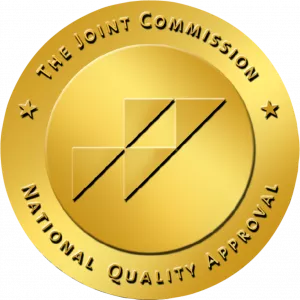It is no secret that there is a tragic opioid epidemic ravaging the United States. As it continues to kill indiscriminately, the conversation across the country on how to effectively stem the tide continues.
Given the wide-ranging nature of how addictions are caused and how they affect the people suffering from them, the frontlines are impossible to confine to a singular space in which to conduct the battle. There is no one policy decision or initiative that will neatly resolve the problem. To make successful inroads, multiple angles have to be addressed and multiple approaches must be employed in concert. Communication between law enforcement agencies, first responders, hospitals, and treatment facilities and professionals are vital to creating a multi-faceted approach that can increase positive outcomes.
As we establish roots in Hoosier country, we are conscious of these realities and fully engaged in understanding the nature of our neighborhood’s particular battle with opioid addiction. The more information and insight we gain of the demographics and trends at play, the better we can appropriately apportion our resources and provide help where it is most needed.
With the help of the Fort Wayne Police Department and its Narcotics Head for the last 8 years, Captain Kevin Hunter, we have prepared some illustrations of the drug battleground in Fort Wayne. Popular drugs of choice, overdose rates and neighborhood distribution and confiscations are included in these graphs and bars. It shed light for us on how to tailor our approach to this specific community. We hope it is a resource that can help all those interested in lending a hand to alleviating the opioid crisis.
About this report
The data used in this report has been compiled from publicly available reports on the Fort Wayne Police Department website as well as data supplied to Avenues Recovery Center at Fort Wayne by Captain Kevin Hunter of the FWPD.
I. Narcotics Investigation Activity: Fort Wayne Neighborhoods
Quick Hitters
- Downtown East Central has been the top area for the last 3 years
- Bloomingdale prominently featured since 2017
- Downtown East River made an initial entrance at No. 3 in the rankings in 2020. Why?
- What is causing the increase in Willow Creek Crossing?
- Numbers in Pettit Rudsill decreasing. Worth investigating what is working there.
- Black Bear apartments have fallen off the chart completely in 2020!
Ranking Fort Wayne Neighborhoods (by number of narcotics investigations)
| Neighborhood | 2020 | 2019 | 2018 | 2017 |
|---|---|---|---|---|
| DOWNTOWN EAST CENTRAL | 1 | 1 | 1 | |
| BLOOMINGDALE | 2 ↑ | 3 | 3 ↓ | 2 |
| DOWNTOWN RIVER EAST | 3 ↑ | |||
| WEST CENTRAL | 4 ↑ | 5 ↑ | 21 ↓ | 1 |
| WILLOW CREEK CROSSING | 6 ↑ | 16 ↑ | 43 ↑ | 102 |
| CANTERBURY GREEN | 7 ↓ | 2 | 2 ↑ | 8 |
| HAMILTON | 8 ↑ | 13 ↓ | 5 ↓ | 3 |
| NORTHSIDE | 9 | 9 ↑ | 11 ↓ | 6 |
| LAREZ | 10 ↑ | 34 ↓ | 33 ↑ | 45 |
| DOWNTOWN WEST CENTRAL | 15 ↓ | 4 ↑ | 6 | |
| PETTIT RUDISILL | 23 ↓ | 6 ↓ | 4 ↑ | 17 |
| BLACK BEAR CREEK APTS | 7 ↑ | 16 ↑ | 68 |
There is good news! Overall, Fort Wayne narcotics investigations are dropping steadily. This tells us that law enforcement efforts and outreach and education initiatives are working. See the yearly and monthly averages steadily dropping here.

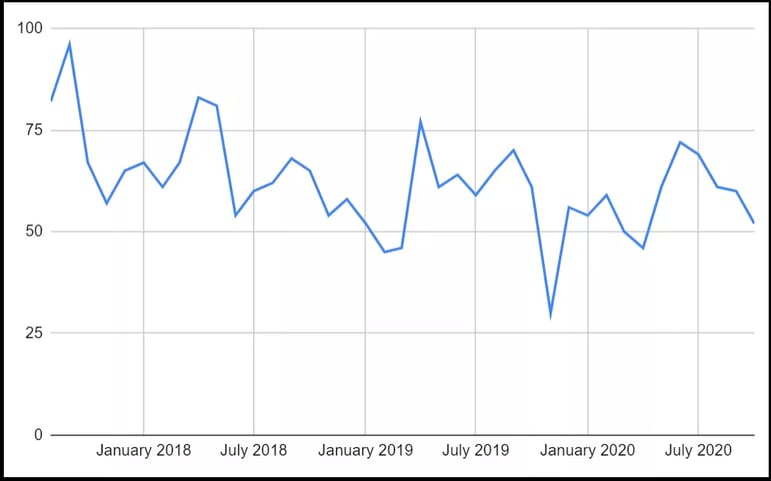
II. Overdose Trends in Fort Wayne
In 2018, over 1000 Indiana residents lost their lives to opioid related overdose.
Early data returns are showing that this number has increased dramatically in 2020. It is a fair assumption to pin this largely on the effects of Covid-19 and its ensuing lockdown measures.
Fort Wayne numbers reflect the distressing trend seen statewide. Through March 2021, there are already more non fatal overdoses that the entire previous year.
See the non fatal overdose trajectory here:

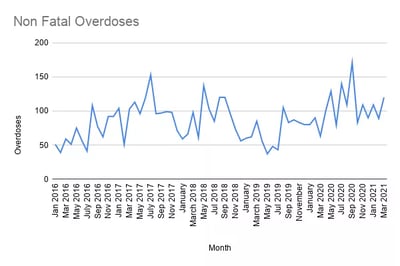
The last three months of the year generally yield lower rates of overdose, and mirrored by a significant increase during summer. It has been conjectured that as winter sets, people are inclined to enter addiction treatment to escape harsh weather. Conversely, summertime is a time when people are out, about, and partying hard. Whatever the right answer is, and it is likely a combination of many factors, we are hopeful the winter downward trend continues here in Fort Wayne.
See monthly breakdowns here:
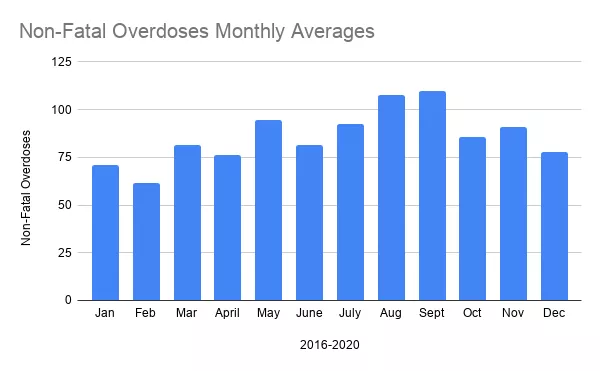
III. Is there a correlation between non-fatal and fatal overdoses?
To save lives from the ravages of the opioid epidemic, there needs to be a concentrated effort on two fronts. Firstly, a focus needs to be placed on preventing overdose in the first place. Initiatives involving education, grass roots outreach and policy making at local levels of government is imperative.
The second point of emphasis is understanding what to do in the event of an occurring overdose. Narcan training and distribution needs to be accessible to the general public. In Fort Wayne, there has been magnificent progress in these areas, as well as a lauded post overdose outreach program called HART. All of these programs deserve our full throated support.
In general, overdose rates have risen in 2020 and continued to rise in 2021. As mentioned above, this can easily be tied to coronavirus. However, in 2019 there was a massive increase in overdoses leading to fatalities. Although, thankfully the numbers have settled back to a more normal pattern this year, understanding its cause would be helpful in preventing it from happening again.
See the overdose fatality rate vs overall overdose here:
| Overdoses | 2016 | 2017 | 2018 | 2019 | 2020 | March 2021 |
|---|---|---|---|---|---|---|
| Non-fatal Overdoses | 804 | 1200 | 1074 | 829 | 1243 | 318 |
| Fatal Overdoses | 68 | 127 | 108 | 144 | 145 | 14 *40 pending toxicology report |
| Total Overdoses | 872 | 1327 | 1182 | 973 | 1388 | 332 |
| Fatality Rate | 7.8% | 9.57% | 9.14% | 14.8% | 10.44% | 4.21% |
Overdose fatality rate, in a chart:

So what caused the 2019 spike? Well, keep reading...
IV. Substance Confiscations by the Fort Wayne Police Department
There are drugs that when ingested are more prone to causing overdose. A closer look at what is more or less prevalent on the streets of Fort Wayne can shed some light on why overdoses killed in larger numbers in 2019.
According to Captain Kevin Hunter, a marked rise in the availability of crystal meth was a significant reason for the increase in fatality rates mentioned above. Indeed, a scan of the data bears this hypothesis to have a firm base in reality. Another cause he mentions is the increase in counterfeit prescription pills that contain fentanyl.
See crystal meth and overdose death correlation here:
2019 Overdose Fatalities
In 2019 the meth confiscation rate for Fort Wayne more than doubled, and the fatal overdose for that year increased almost 62% from 9.14% to 14.8% 
An almost prophetic article about this trend was written by Shari Rudvasky for Indystar in September 2019. That piece connects fentanyl with this dangerous trend.
V. Other drugs of note and their confiscation rates:
Marijuana Confiscations
After a large spike in 2019, Marijuana confiscations have dropped off the table. Synthetic Marijuana peaked in 2015 and has almost disappeared.
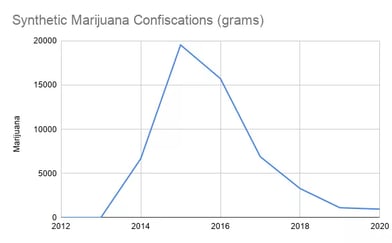
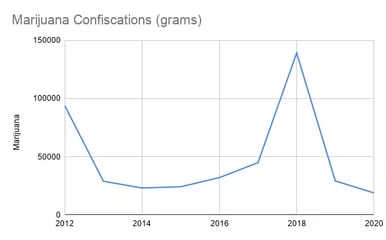
Pills
Pills have been on the rise since 2015. (2020 number here is projected and is subject to change per year end data collection)
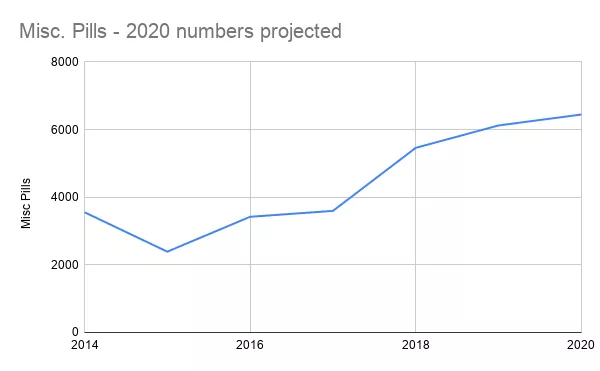
An Interview with Captain Kevin Hunter
Captain Hunter has led the fight against the opioid epidemic in Fort Wayne for the last 8 years. In his role as chief of the narcotics division of the Fort Wayne Police Department, his vantage point and vast experience in the field is an invaluable resource. We are grateful for his graciousness in sharing the data he has compiled, and are inspired by his passion for helping all of those battling drug and alcohol addiction. Here are some of this thoughts on the data sets above.
I think the answer to this question is very complicated. I think 2019’s low number of non-fatal overdoses is due to the availability of Narcan by Officers, EMT’s and Fire Fighters who respond to overdoses. I also think that the distribution of Narcan by the Allen County Department of Health and our HART Detectives has helped as well.
We started seeing Fentanyl on the streets in 2015 along with a rise in overdoses. 2017 was a really bad year for Fort Wayne with Fentanyl with record drug seizures, and fatal and non-fatal overdoses. 2019 saw a huge increase in crystal meth, and thus we had a record year for fatal overdoses. This year we’ve seen a huge increase in non-fatal overdoses compared to last year. This is quite possibly due to Covid-19 and people being isolated. Another challenge we face is that we know all of the hospitals in Fort Wayne have walk-ins who have overdosed, yet we cannot get those numbers from the hospitals to get an accurate count on this problem, due to HIPPA constraints.
It seems that the Fort Wayne illegal drug market is significantly impacted by Mexican drug cartels. Last year we saw the biggest increase in crystal meth seizures that we’ve ever had. We know that certain drug cartels have a direct influence on what is imported into this area. Crystal meth was extremely easy to find and very cheap in 2019. It led to a flooding of the Fort Wayne market with this product. Interestingly, crystal meth entered the United States in 2019 at record levels by Mexican Drug Cartels. I think that availability and price drive what we see in the drug market here in Fort Wayne.
My team was working with the FBI on an Organized Crime Drug Enforcement Task Force (OCDETF) Case, and we raided and arrested several targets that had LARGE amounts of marijuana.
It seems that heroin is harder to come by over the last few years, but fentanyl is very prevalent. I think it comes back to availability. Right now fentanyl is very prevalent on the streets and that seems to be what the person with substance use disorder is buying.
Kevin Hunter
A 30 year veteran of the Fort Wayne Police Department, Captain Hunter has spent the last 8 years as the Chief of the Narcotics Division.
Captain Hunter graciously joined the Rubber Bands podcast for a more in depth discussion as well. Listen below or read the full transcript here.


